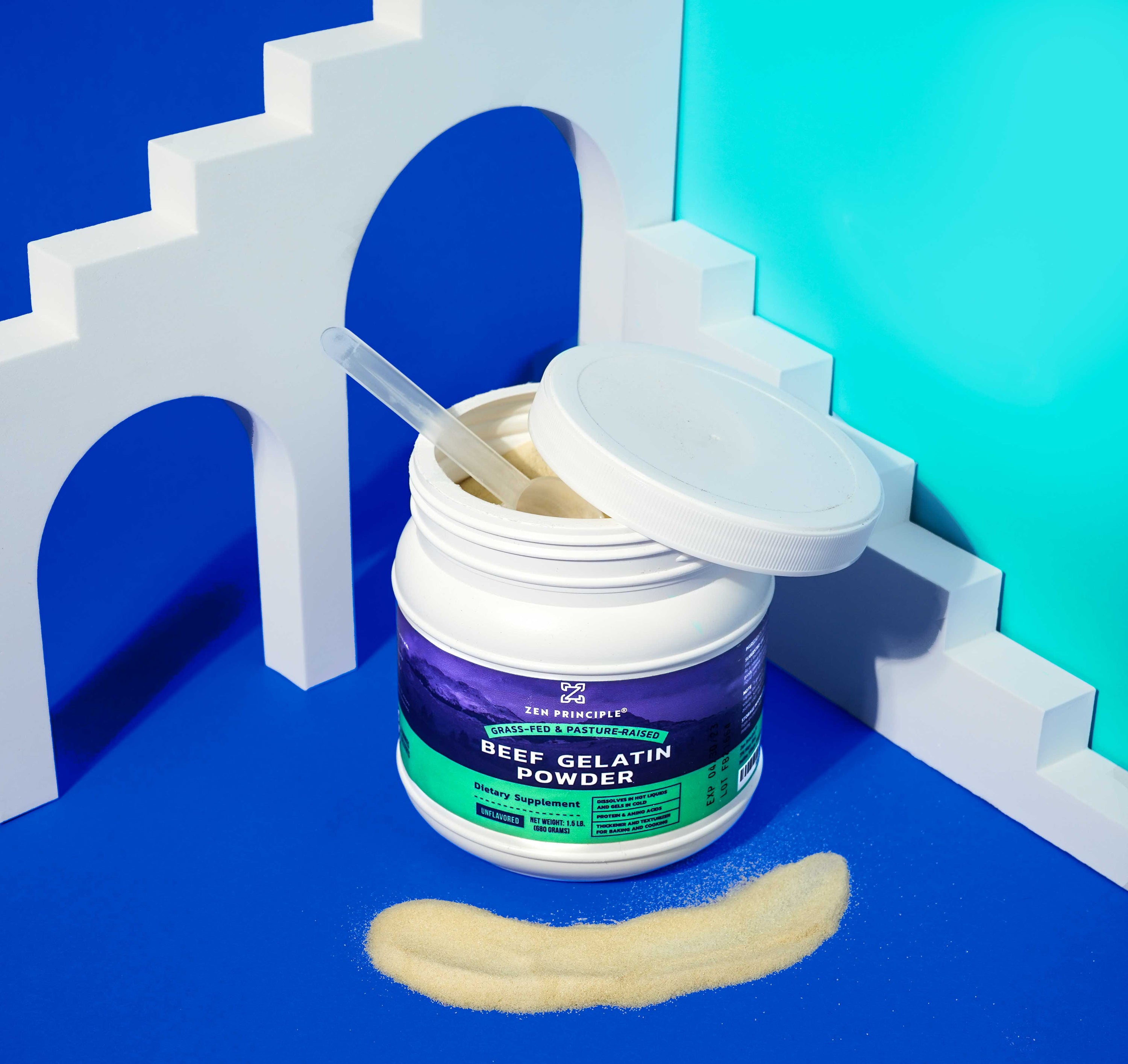You’ve likely heard a lot about the benefits of beef collagen and how grass-fed collagen trumps grain-fed. Yet, what about grass-fed gelatin?
In this post, you'll learn how grass-fed gelatin is produced and why — like its collagen counterpart — it’s better than grain-fed gelatin.
How Is Grass-Fed Gelatin Made?
Gelatin comes from many sources, such as marine animals and pigs. For the purpose of this article, we’ll focus on grass-fed beef gelatin.
Grass-fed gelatin is partially hydrolyzed collagen extracted from grass-fed beef. In human-speak, that means the collagen is first boiled at temperatures higher than 40 degrees Celsius. This breaks it down into smaller chains known as gelatin. Once cooled, gelatin takes on a jelly-like form that’s both colorless and flavorless. As such, gelatin is also referred to as a collagen by-product.
Because grass-fed gelatin is derived from grass-fed collagen, both of them share a similar nutritional profile. Except for tryptophan, a 1955 study noted that gelatin retains all other essential and non-essential amino acids present in collagen.
A Healthline article also revealed the nutritional composition of gelatin:
- Glycine: 27%
- Proline: 16%
- Valine: 14%
- Hydroxyproline: 14%
- Glutamic acid: 11%
As you can see, both gelatin and collagen are great supplemental sources for the human body. But what’s the advantage of gelatin over collagen?
For starters, collagen itself may contain trace amounts of protein impurities. Gelatin, being extracted after boiling collagen, is generally free of such contamination.
In fact, the same 1955 study even suggested that “gelatin may represent highly purified collagen in amino acid composition.” It further mentioned that “gelatin is representative of the main protein constituent of collagenous tissues in amino acid composition.” In which case, if you’re on the hunt for a high-quality gelatin supplement, you’ll want to check out Zen Principle Beef Gelatin Powder.
On top of that, there are various health benefits of gelatin, which we’ve covered extensively in our guide.
Grass-Fed vs. Grain-Fed Gelatin: Understanding the Terminology
Given that beef products are often categorized into grass-fed and grain-fed, it’s no surprise that grass-fed and grain-fed gelatin exist, too. Yet, what are the differences between the two?
If you’ve read our guide on grass-fed collagen, you probably have a good idea about said differences. Let’s do a quick recap.
First, here’s how to differentiate grass-fed gelatin from grain-fed gelatin:
- Grass-fed gelatin comes from grass-fed beef collagen.
- Grain-fed gelatin is made from grain-fed beef collagen.
Sounds simple, right? Not quite so. That’s because grass-fed beef collagen may not be 100% grass-fed in reality.
Based on the definition by the North American Meat Institute (NAMI), 100% grass-fed cattle are “fed only grass (or an equivalent of dried forage) their entire lives.” On top of that, the U.S. Department of Agriculture (USDA) also stated that “grass and forage shall be the feed source consumed for the lifetime of the ruminant animal, with the exception of milk consumed prior to weaning.” In other words, an entirely grass-fed beef product, like gelatin, must come from cows that weren’t fed any grains in their diet.
As you can imagine, not many cattle producers have the resources to abide by such strict standards in producing 100% grass-fed beef, and by extension, pure grass-fed gelatin. In which case, there’s a large proportion of cattle who are given a grain-fed diet for most of their life. When these cattle finish up on the pasture in the few months before slaughter, the resulting product is grass-finished beef.
From a consumer’s point of view, it can be easy to mix up grass-fed and grass-finished products, so pay particular attention to the labels.
What about grain-fed gelatin? This comes from cows who eat a grain-based diet right after weaning up till they are slaughtered. Because grain-fed cattle are raised in feedlot farms — think concentrated animal feeding operations (CAFOs) — grain-fed beef is often referred to as feedlot-finished beef.
The Downsides of Grain-Fed Beef Products
While some people prefer grain-fed meat for its taste, it should be noted that it comes with various downsides:
- Grain-based diets are often linked to bovine health issues like bloating in the stomach, pus-filled masses in the liver, and tissue inflammation in the hooves. As you can imagine, unhealthy cows often lead to low-grade beef products.
- Feedlot farming features poor living conditions — think cramped, unclean spaces — that lead to physical and mental health problems in the animals. Common examples include sneezing, coughing, diarrhea, and nasal discharge.
- To counter the above health problems, cattle producers tend to overuse antibiotics. This leads to a new complication of antibiotic resistance developing in this livestock. When we consume them, there’s a chance that the antibiotic resistance may filter down to us, too.
In other words, grain-fed beef products are typically derived from sickly, antibiotic-pumped cattle. Rather than choose grain-fed beef gelatin, it’s better to go with grass-fed sources as they are more representative of healthy, antibiotic-free livestock. At the end of the day, you are what you eat.
The Upside of Grass-Fed Gelatin
We’ve already established that grass-fed gelatin is, by far, the healthier, safer choice. But did you know that it’s also extracted from more nutritious beef?
Scientific evidence indicates that a grass-based diet is synonymous with a better beef nutritional profile. Grass-fed meat is found to possess higher amounts of:
- Omega-3 fatty acids, which are beneficial for your health health
- Cholesterol-neutral stearic fatty acids
- Precursors for your body’s production of vitamin A, vitamin E, and glutathione (which fights cancer)
- Collagen, which can be used to make gelatin
So, while grass-fed beef products may be a little pricier than their grain-fed counterparts, their superior nutritious quality is more than worth it.
What To Look Out for in Grass-Fed Beef Gelatin

You've probably heard the Food and Drug Administration (FDA) does not regulate the sale of dietary supplements. To help you choose top-quality grass-fed gelatin supplements, we’ve created this simple checklist:
- Is it 100% grass-fed? Remember, purely grass-fed gelatin should read “grass-fed”, and not just “grass-finished” on the product label. If you aren’t clear, you can always contact the brand’s customer service or FAQ page.
- Is the ingredient list short and clean? Another way to double-confirm the product is indeed 100% grass-fed gelatin, the ingredient list should be short and clean. This means it’s free of fillers, additives, artificial sweeteners, antibiotics, and genetically modified organisms (GMOs).
We’re happy to say that our Beef Gelatin Powder fits these criteria to a tee. For more information on whether our supplement is exactly what you need, hop over to the FAQs page.






